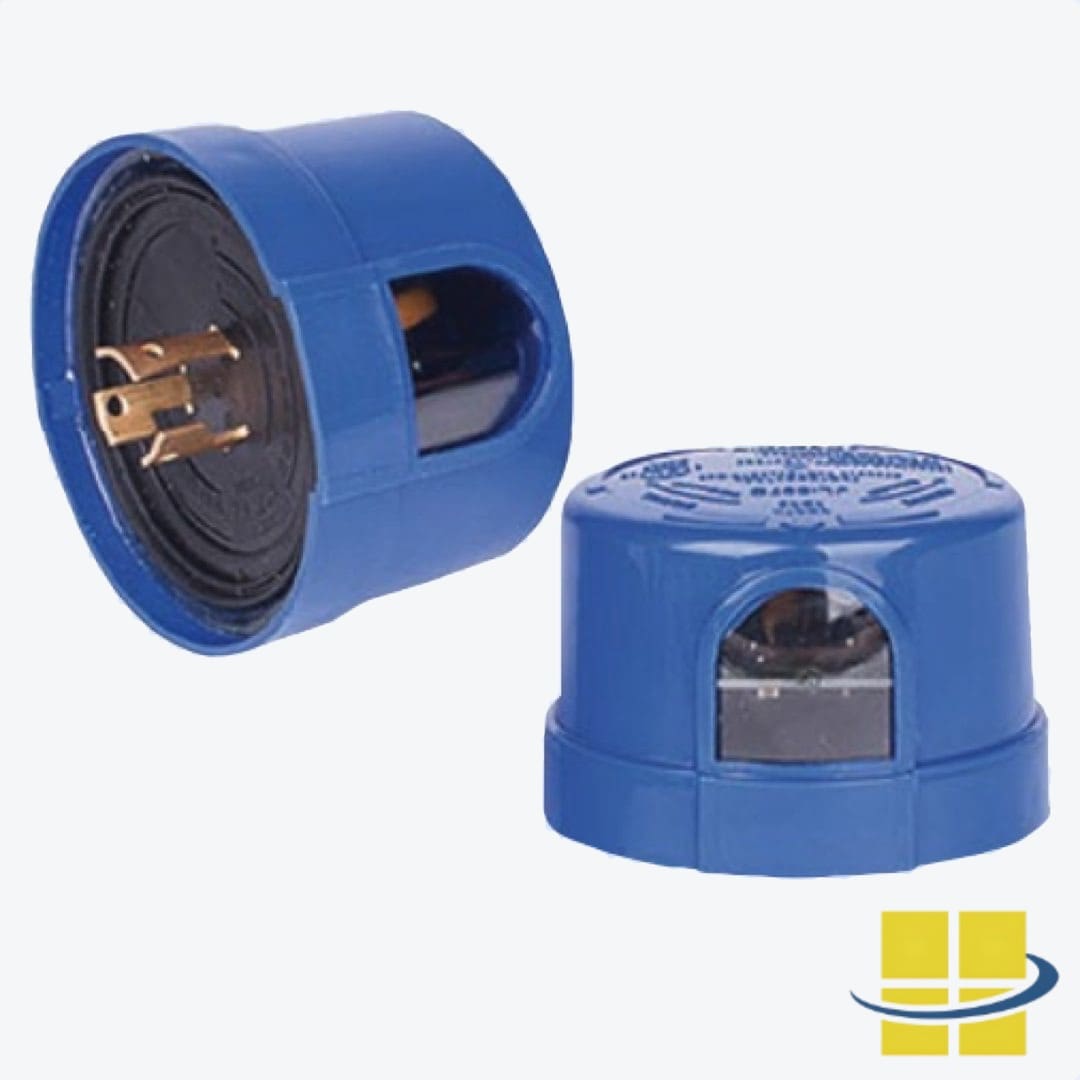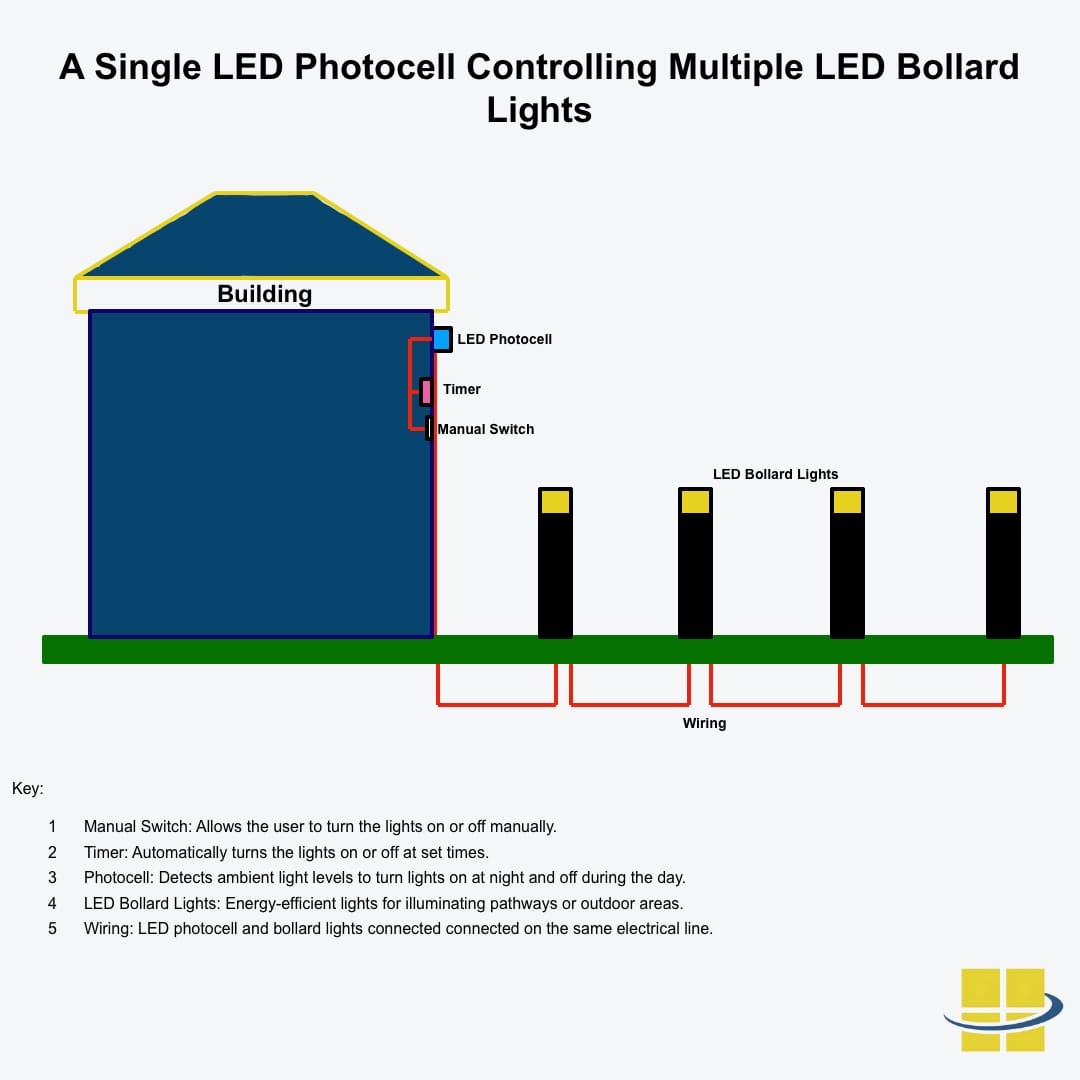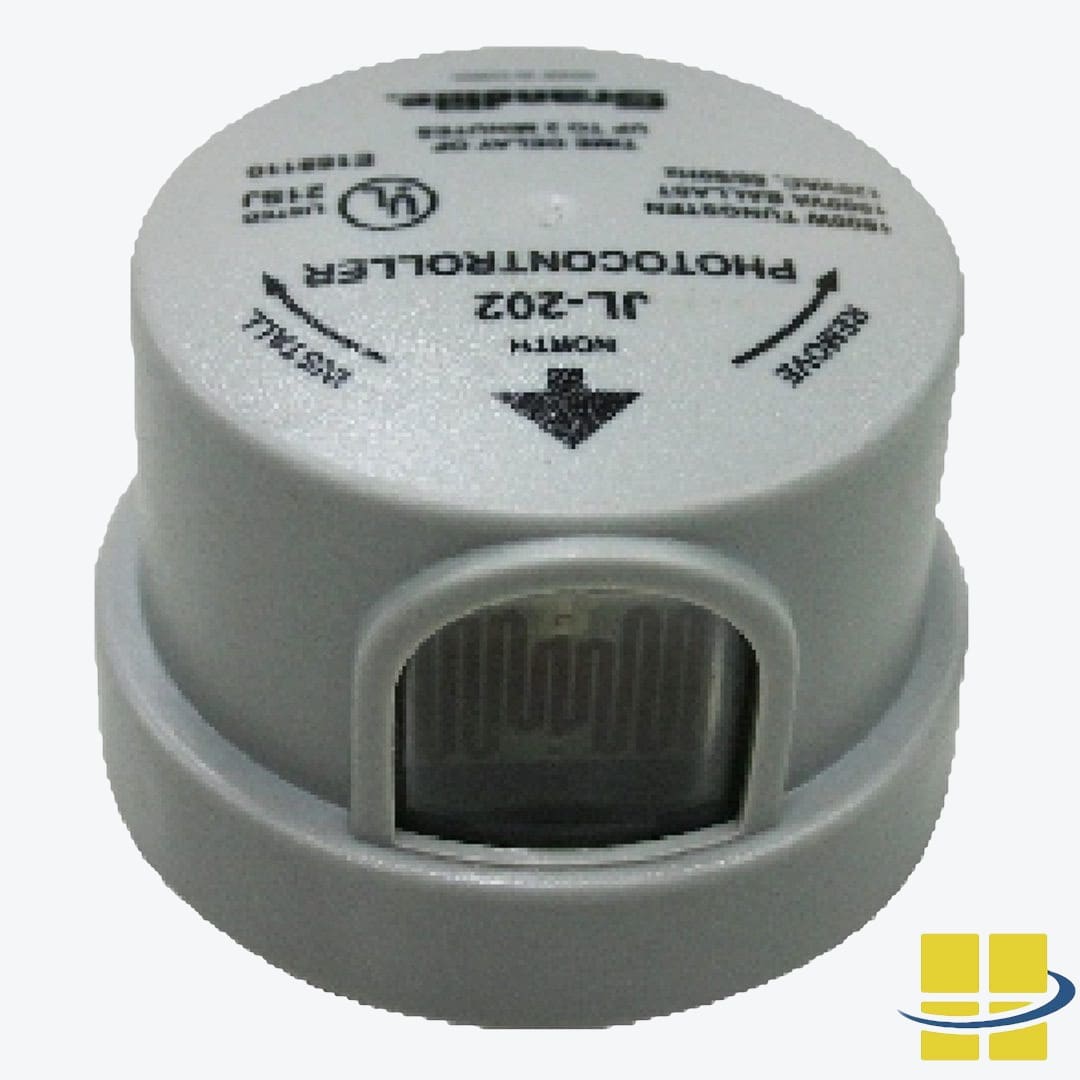Here is an LED Photocell Q&A, where we address common questions and provide expert advice on lighting solutions. The question is ‘How to wire a photocell to multiple lights?’ We will focus on using photocells with bollard lights for pathway illumination. LED Photocells are an efficient way to automate lighting, ensuring your pathways are well-lit at night without the need for manual intervention. Whether you are a homeowner, a facility manager, or a landscape designer, understanding how LED photocells work can greatly enhance the efficiency and effectiveness of your outdoor LED lighting system.
Key Takeaways
-
- Single Photocell Control: One LED photocell can manage multiple bollard lights if they are on the same power line.
- Energy and Cost Efficiency: LED Photocells provide efficient lighting control, reducing energy consumption and operational costs.
- Automated Lighting: LED Photocells ensure your outdoor lighting adapts to changing light conditions, providing consistent illumination.
Understanding Photocells and Exterior Lights
Photocells are ingenious devices that detect changes in light levels and automatically control exterior lights. They are widely used in outdoor lighting applications, such as parking lot lights, LED flood lights, and LED pole lights. Photocells work by sensing the amount of ambient light and sending a signal to the light fixture to turn on or off. This automatic control helps reduce unnecessary power consumption and extends the lifespan of the lights, making them an efficient choice for outdoor lighting.
The Basics of Photocells
What is a Photocell?
A photocell, also known as a photoelectric sensor, is a device that detects light levels and responds accordingly. It functions as an automatic switch that turns on the connected luminaires when the ambient light falls below a certain level and turns them off when there is sufficient natural light. This capability makes photocells an essential component for outdoor lighting systems, ensuring that lights are only on when needed.
How Do Photocells Work?
Photocells operate based on the principle of photoelectric effect. When light hits the photocell sensor, it generates an electrical current. The amount of current produced is proportional to the intensity of the light. A threshold is set within the photocell, and when the light intensity falls below this threshold, the photocell activates the connected lights. Conversely, when the light intensity exceeds the threshold, the photocell turns the lights off.
Benefits of Using Photocells
Photocells were developed to eliminate the need for manually turning on outdoor lights every evening and off every morning. They offer several advantages over traditional timers, including:
- Efficiency: Photocells respond to actual light levels, while timers operate based on preset times, which may not account for seasonal variations and Daylight Savings Time.
- Consistency: Using a single photocell ensures all connected lights turn on and off simultaneously, providing uniform illumination.
- Energy Savings: By only operating lights when needed, photocells contribute to energy savings and reduce electricity costs.
Practical Application: Controlling Multiple Bollard Lights
Scenario: Illuminating a Pathway with Bollard Lights
Imagine you are planning to illuminate a pathway with 18 LED bollard lights. You want these LED lights to automatically come on at night (lighting dusk), and turn off during the day. A common question arises: Do you need to purchase 18 lighting photocells, one for each bollard light?
The Answer: No, You Only Need One Photocell
A single photocell can control multiple LED luminaires if they are on the same electrical line. This setup is not only more cost-effective but also simpler to manage. Here’s how it works:
- Power Source: Ensure ample power is provided from a mainline to a photo switch, which controls the power flow.
- Electrical Box Placement: Install an electrical box in a location that can detect natural light without interference from the luminaires.
- Photocell Installation: Mount the photocell on the electrical box. This photocell will act as a secondary switch.
- Manual Switch: Allows the user to turn the lights on or off manually.
- Timer: Automatically turns the lights on or off at set times.
- Wiring: Connect the power line from the first switch to the photocell and then to each of the 18 LED bollard lights.
- Operation: When the primary switch is on, the photocell will detect darkness and turn on all the LED bollard lights simultaneously.
Benefits of a Single Photocell System
- Simplified Installation: Using one photocell reduces the complexity of the installation process.
- Cost Savings: Purchasing and installing a single photocell is more economical than buying multiple units.
- Uniform Control: Ensures all lights turn on and off at the same time, providing consistent illumination along the pathway.
Choosing the Right Photocell
Types of Photocells
While photocells are generally versatile, some types are better suited for specific applications. It’s advisable to consult with an electrician to determine the best photocell for your lighting setup. The photocell shown in the image is a standard model that works well for many applications. Here are three (3) types of photocells, their features, and applications:
Twist Lock Photocells
Description: Twist lock photocells are commonly used in street lighting, parking lot lighting, and other outdoor applications. They are named for their installation method, which involves twisting and locking the photocell into a compatible socket on the lighting fixture.
Features:
- Easy Installation and Replacement: The twist lock design allows for quick and tool-free installation and replacement, making maintenance straightforward.
- Durability: These photocells are typically weather-resistant and designed to withstand harsh outdoor environments, ensuring long-term reliability.
- Standardization: They follow a standardized design (such as ANSI C136.10), making them compatible with various lighting fixtures from different manufacturers.
Applications: Twist lock photocells are ideal for large-scale outdoor lighting systems, such as streetlights, parking lots, and sports facilities, where ease of maintenance and durability are critical.
Button Photocells
Description: Button photocells, also known as mini photocells, are compact devices that can be integrated directly into lighting fixtures. They are smaller than twist lock photocells and are often embedded within the fixture housing.
Features:
- Compact Size: The small form factor of button photocells makes them suitable for fixtures where space is limited.
- Seamless Integration: These photocells can be integrated into the fixture design, providing a clean and unobtrusive appearance.
- Versatility: Button photocells can be used in various lighting applications, both indoor and outdoor, due to their compact and versatile design.
Applications: Button photocells are commonly used in residential and commercial lighting applications, including wall packs, bollards, and landscape lighting, where aesthetics and space efficiency are important.
Coin Slot Photocells
Description: Coin slot photocells, named for their coin slot-like appearance, are another type of photocell used for controlling LED lighting. They are typically smaller than twist-lock photocells and are designed for easy installation.
Features:
- Simplicity: Coin slot photocells are straightforward to install and use, often requiring just a simple slot-in mechanism.
- Cost-Effective: These photocells tend to be more affordable than other types, making them an economical choice for basic lighting control needs.
- Suitable for Various Fixtures: They can be used in a variety of lighting fixtures, from security lights to pathway lighting.
Applications: Coin slot photocells are suitable for cost-sensitive projects where basic photocell functionality is required, such as residential outdoor lighting, security lights, and pathway lighting.
Choosing the Right Location and Installation
Selecting the right location for a photocell is crucial for its effective operation. The photocell should be placed where it can detect natural light without interference from the LED lights it controls. Ideally, it should be shielded from direct sunlight and harsh weather conditions to ensure accurate light detection. When installing a photocell, always follow the manufacturer’s instructions to ensure a secure and proper connection to the light fixture. This careful placement and installation will ensure your exterior lights operate efficiently and reliably.
Wiring a Photocell to Multiple Lights
Wiring a photocell to multiple lights requires careful attention to detail. Typically, a photocell sensor has three wires: black, red, and white. The black wire connects to the 120-volt power source, the red wire connects to the light’s black wire, and the white wire connects to both the light’s white wire and the photocell sensor’s white wire. When wiring multiple lights to a single photocell, ensure all lights are connected in parallel and that the total wattage does not exceed the photocell’s capacity. This setup will allow the photocell to control multiple lights efficiently.
Testing and Troubleshooting
To test a photocell sensor, cover the sensor to simulate darkness and check if the LED lamps turn on. When you uncover the sensor, the lights should turn off. If the lights do not respond as expected, check the wiring connections to ensure they are secure and correct. Troubleshooting may involve inspecting for loose connections, faulty wiring, or a malfunctioning sensor. Ensuring the photocell sensor is properly connected to the light fixture is key to its correct operation.
Safety and Energy Efficiency
Photocells are designed to enhance safety and energy efficiency in outdoor lighting applications. By automatically turning lights on and off based on ambient light levels, photocells help reduce unnecessary power consumption and extend the lifespan of the lights. This automatic control also helps prevent accidents by ensuring exterior lights are on when needed. When installing a photocell, always follow safety guidelines, such as turning off the circuit breaker before starting the installation process. This ensures a safe and efficient setup for your outdoor lighting system.
Factors to Consider
- Sensitivity: Some photocells have adjustable sensitivity settings to fine-tune when the lights turn on and off.
- Weather Resistance: Choose a photocell that can withstand the environmental conditions of your location, including temperature extremes and humidity.
- Compatibility: Ensure the photocell is compatible with the type of lighting fixtures you are using.
- Energy Efficiency: Dusk-to-dawn photocell sensors are highly energy-efficient as they detect ambient light levels to automatically turn outdoor lights on and off, preventing unnecessary power consumption during daylight hours.
Installation Guide
Step-by-Step Installation
- Planning: Determine the optimal location for the photocell where it can detect natural light but is not influenced by the lights it controls.
- Electrical Box: Install an electrical box at the chosen location.
- Mounting the Photocell: Secure the photocell onto the electrical box.
- Wiring: Connect the power line from the primary switch to the photocell and then to each of the bollard lights.
- Testing: Once installed, test the system by simulating dusk and dawn to ensure the photocell activates the lights correctly.
Safety Tips
- Turn Off Power: Always turn off the power at the circuit breaker before starting the installation.
- Follow Local Codes: Ensure the installation complies with local electrical codes and regulations.
- Professional Help: If you are not comfortable with electrical work, hire a licensed electrician to perform the installation.
Maintenance and Troubleshooting
Regular Maintenance
- Clean the Sensors: Clean the photocell light sensors to ensure accurate light detection. Wipe it with a soft cloth periodically.
- Check Connections: Periodically check the electrical connections to ensure they are secure and corrosion-free.
- Test Functionality: Regularly test the photocell to ensure it functions correctly and adjust the sensitivity if necessary.
Common Issues and Solutions
- Lights Not Turning On: If the lights do not turn on, check if the photocell is receiving power and that the sensor is not obstructed.
- Lights Staying On: If the lights stay on during the day, the photocell might be faulty or incorrectly installed. Verify the placement and settings.
- Inconsistent Operation: Fluctuations in light levels due to nearby reflective surfaces or obstructions can cause erratic operation. Adjust the location or sensitivity of the photocell.
This may require consulting a licensed electrician for professional guidance.
Purchasing Photocells and Bollard Lights
Photocells can be purchased alongside bollard lights from Access Fixtures. Our lighting specialists are available to answer any additional questions and provide guidance on selecting the right products for your needs. Here are some key considerations when purchasing:
- Compatibility: Ensure the photocell is compatible with your specific lighting fixtures and power requirements.
- Quality: Choose high-quality photocells to ensure reliability and longevity.
- Support: Take advantage of expert advice and support from our lighting specialists to help you make informed decisions.
Conclusion
In conclusion, photocells are an essential component of outdoor lighting systems, providing energy-efficient and automated lighting control. By understanding the different types of photocells, factors to consider, and tips for installation and maintenance, you can ensure that your exterior lights are working efficiently and effectively.
Remember to choose a photocell that suits your specific needs, considering factors such as timing, sensitivity, and compatibility with your lighting system. With the right photocell, you can enjoy the benefits of automated lighting control, including reduced unnecessary power consumption and increased safety.
By following the tips and considerations outlined in this article, you can ensure that your photocell is working correctly and providing the desired level of lighting control. Whether you’re looking to upgrade your existing outdoor lighting system or install a new one, a photocell is an essential component to consider.
By understanding how photocells work and how to implement them efficiently, you can enhance the functionality and convenience of your outdoor lighting system. Whether you are illuminating pathways, gardens, or other outdoor areas, a well-chosen photocell can make all the difference. For more information and to purchase photocells and bollard lights, contact an Access Fixtures lighting specialist today.
Frequently Asked Questions (FAQs)
LED Photocells are a highly efficient option for allowing outdoor lights to turn on and off. Certain types of photocells work better with some products over others, which is usually left to an electrician’s discretion. The photocell shown in the image above is a typical photocell that works well for many applications. Photocells may be purchased from Access Fixtures when you purchase bollard lights. If you have any other questions, please contact an Access Fixtures lighting specialist for assistance.
Why is it important to turn off the circuit breaker before installing a photocell sensor?
Turning off the circuit breaker before installing or wiring a photocell sensor is crucial for ensuring safety during the process. The circuit breaker, often situated outside the premises, should be located and turned off to prevent electrical hazards. If you are unsure about its location, it is recommended to seek professional assistance.
What is the practical application of a photocell sensor in a dusk-to-dawn lighting system?
A photocell sensor is commonly used in dusk-to-dawn lighting systems to automatically control outdoor lights. This sensor detects the ambient light levels and turns the lights on at dusk and off at dawn. Wiring a photocell sensor for such a system involves specific steps and safety precautions, including turning off the circuit breaker and following detailed wiring instructions.
Can photocells be used with any type of outdoor lights?
Yes, photocells can be used with various types of exterior lights, including bollard lights, pathway lights, and security lights.
How do I choose the right location for the photocell?
Install the photo cell in a location that can detect natural light without being influenced by the LED lights it controls.
What happens if the photocell fails?
If the photocell fails, the connected LED lights may stay on continuously or not turn on. It is important to check and replace faulty photocells promptly.
Are there different types of photocells for different climates?
Yes, there are photocells designed to operate in various environmental conditions, including extreme temperatures and humidity.
Can photocells be adjusted for sensitivity?
Some photocells have adjustable sensitivity settings to fine-tune when the LED lights turn on and off.
How do I test a photocell sensor?
To test a photocell, cover the sensor to simulate darkness and see if the LED lamps turn on. Uncover the sensor to check if the lights turn off. It is crucial to correctly identify and connect the white wire when testing a photocell to ensure the proper functionality of the light system.
Can photocells work with LED lights?
Yes, photocells are compatible with LED lights and can be used to control them efficiently.
Do photocells require regular maintenance?
Yes, photocells should be cleaned periodically to ensure accurate light detection and checked for secure connections and proper functionality.
Is it better to use a timer or a dusk to dawn photocell?
Photocells are generally more efficient than timers because they respond to actual light levels, whereas dusk to dawn photocells operate on preset times which may not account for changing light conditions.




